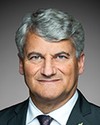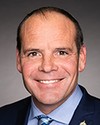moved that the bill be read the third time and passed.
Madam Speaker, it is a pleasure to rise here on Bill C-248. I thank all the members in the House for getting it here. In particular, I thank the Conservative Party, the Bloc Québécois, the Green Party and also two Liberal members who supported it.
We have tried to work with the government on this, and I will get into that later. Unfortunately, to date, it has not joined us, but we shall see. I have tried to use this place as constructively as possible, especially given the fact that Canadians have shown they want us to work together. Unfortunately, the government has not done so at this time.
I will reference a quote on the Parks Canada website, which I think dismantles some of the government's objections to this private member's bill. It is key to our democracy. When one thinks about the work that goes into private member's business, it does not matter where one is from and what the legislation is about. It is our right to be heard, and it is our right to change our Canada outside of the partisan envelope.
I got lucky in being picked to be put up high on the Order Paper for this bill. I could not think of something stronger to put forward. I have been trying to push for a new border crossing in Windsor. My first public meeting as a city councillor was for a new public border in 1998 at Marlborough Public School. The proposed legislation that I have today is for a property next to it that goes along that entire border process that would create a national urban park for all of Canada. It would protect 200 of Canada's 500 endangered species. It is supported universally by groups.
I will read from a Facebook post by the government's own Department of Environment. On June 23, 2022, the Parliament of Canada posted the following on its Facebook page:
Did you know that national parks are created through Acts of Parliament?
On this day in 1887, Parliament passed the Rocky Mountain Parks Act, which established what is now Banff as the first national park in Canada.
Today, there are 48 national parks. They are found in every Canadian province and territory.
The Parliament of Canada acknowledged in its post, on the anniversary of this law for Banff, that national parks are created by acts of Parliament. It is very helpful today, because now the government insists it wants to go through some process that is still being drafted to deal with this issue. However, what we have done is a responsible, accountable, transparent and inclusive process for this legislation. This legislation is going to amend the Canada National Parks Act.
That is how every single national park has been created. This is how we could go about fixing a situation in Windsor. It is an opportunity to provide some restoration with regard to reconciliation. One of the most important partners that we have in this process is Caldwell First Nation.
I will help citizens picture this area. Where I am from, in southern Ontario, the Detroit River runs right through our city, but there is also a connection of the lake system for the Great Lakes.
What has happened is that, unfortunately, we have done what a lot of places have done. We chopped, milled and cut down all the trees. We moved in with agriculture and manufacturing. It has left very little green space. However, because of our location and our temperate environment, we have Carolinian forests that provide a refuge for species at risk. That includes trees and fauna, amphibians, the Massasauga rattler and others that are endangered. Similar to many other places in the country, we are fighting to get these green spaces back.
There is a unique element of this process that needs to be put to the test. This is all public land. There is no private land. The government will say now, out of desperation, that some of it is private property, but it has not provided any geographical evidence about those locations. We would want to get those things out anyway.
It is important to note that we are unifying public lands through this process. There is no position whatsoever that we want, other than to be able to work with the City of Windsor, which supports this bill, and to be able to work with Caldwell First Nation, which supports this bill. The Province of Ontario just passed a motion in the legislature about this bill. On top of that, we have several environmental groups that have all shown support for this bill. It is truly grassroots. It comes from the fact that we have these endangered species that need a better level of protection than they get through the hodgepodge system we have now.
One thing we did fight for along this area of the Detroit River, as it extends into other parts of the city along that front, is the shoreline that the Windsor Port Authority still has not transferred over. I want to remind all members of Parliament that port authorities are the creations of Parliament under the Marine Transportation Security Act and are no different from Canada Post or anything else. They operate through regulation, but it is the people's land.
It was that area that some developers tried to bulldoze and clear-cut. Fortunately, I was working with one of the developers in the area who tried to get involved in the project. I called the person up and said, “Do you realize what is happening? Do you realize what you are going to be part of?” That person took out their position in support of the project at their own cost, and the property has now been saved for the future. It is supposed to be transferred, but we are still waiting for that to happen.
There is no time to wait when we think about the property I am talking about. When the Gordie Howe bridge, which is next to it, is built, 40,000 vehicles per day could potentially traverse it, with up to 10,000 transport trucks per day, and we do not have environmental assessments on how that is going to take place. The Gordie Howe bridge is a large piece of infrastructure that crosses two and a half kilometres of the Detroit River and onto the territory of the Caldwell First Nation. Chief Duckworth, who has been to Ottawa with me several times, has appeared at press conferences and is basically a mentor in many respects.
Caldwell First Nation is part of the restitution with this country. When it fought with the British, it was promised the Point Pelee area. After that, its members were burned out of their properties, went through a long process and finally have a good settlement now. They are setting up a proper reserve and are doing very well with other types of initiatives. They are the land stewards of this area. This is one of the good-news stories.
Members of the Caldwell First Nation have stood shoulder to shoulder with us during this process. In fact, they were the first group I brought down here when I was trying to save Ojibway Shores to see if they had interest in the property. At that time, they did not because they wanted to go toward Leamington, which is next to Point Pelee, and they have that land now. The beautiful part of this story is that despite being forced out in the past, they are now co-managers of Point Pelee National Park. They will also be co-managers of the park that we are proposing here. This story highlights what we should be doing right.
Chief Duckworth, who has been very good on this, said this at committee: “We know that we need a legislative framework in order to make this national park happen, and I am here to support the hard work that's been done and the hard work going forward.” Members of the Caldwell First Nation sent several letters, which have gone to all members in this chamber. Again, they have showed a path forward.
Across the Detroit River, the Wyandot community is also supporting this bill, and I will get into this a bit because it is international. The Wyandot community, another aboriginal organization, has sent in a letter of support for this.
I want to point out that a private member's bill can be done in a non-partisan way. The member for Essex has been terrific on this and has been supportive in the past. We have seen members come and go, and one of the previous members, Jeff Watson, whom I used to work with and who was from the Conservative Party, supported this. Even though we may not have always seen things the same, we knew how to work on local interests.
The current member for Essex said this:
This is a very unique opportunity for the folks of Essex. I've said it before and I'll say it again. We are somewhat landlocked in Windsor-Essex, in that we're surrounded by three bodies of water. I've spoken extensively with Mayor Dilkens, the mayor of Windsor; Mayor Bondy, the mayor of LaSalle; and Mr. Watson, the previous member of Parliament. We've done our due diligence. Everybody says this is a fantastic thing to do.
The member has also brought up an issue that I think gets under-reported, which is about mental health and getting out to other spaces. I want to thank the member for Essex for that, because sometimes we lose some of the other lenses we view things through. That is why it has been important for me to have this type of support.
I also want to thank the Bloc Québécois for making sure that this is understood as a very unique project that really defines our area. What many people do not know is that Sandwich Town, which is right next to this area, is the oldest European settlement west of Montreal with a francophone culture that is still part of its rich vibrancy. In fact, the Detroit River, with its first nations and the French settlements, had a seigneurial system where farming came up. We have a number of French names throughout the city system, which run north to south, and after the British came, British names ran east to west. We have this combination, but the francophone culture is very strong. In fact, a new hub centre is a couple of blocks from my house, so the language is going strong with some of our new Canadians who are by this area.
This is a social justice issue in many respects, because if we amend the National Parks Act as we want to, it will give it the same stature as Point Pelee and other parks, and it deserves it because of the hundreds of endangered species. On top of that, the area it is next to, as I referenced, Sandwich Towne, has been one of the poorest places in Canada in many respects with child poverty and single mothers. We have dealt with a series of different poverty issues over the years because the international border and Matty Moroun, a private American billionaire who passed away and whose son owns the property now, caused a lot of interesting and very difficult problems over a number of years, including buying and boarding up homes. Why this is important is that we need to do this right.
When we fought to get the Gordie Howe bridge, there were those who said we should twin the Ambassador Bridge. Even the Prime Minister gave them an order in council to do that a few years ago and let a billionaire family have its way with Canada. We said “no” to that. OMERS, one of the largest pension funds, wanted to run a truck route through my riding. We said “no” to that.
What did we do? We fought for the right thing, which is a brand new public crossing. It was a compromise we got, which is now the Gordie Howe bridge, that will provide economic security for all of us, as well as environmental advantages. The same battle is happening right here.
We said we were open to amendments. I worked with the minister after the Liberals voted against it. We had meetings and several different things. They went to committee with those amendments, and one of their own Liberal members ruled the minister's amendments out of order. I was asked by the Liberals in the morning what happened. I said that, first, their parliamentary secretary and others were not there and, second, I did not know, and that they have to figure out what is going on in their own party. In 20 years, I have never seen a minister's own amendments ruled out by a member of the minister's own party. That was something I cannot explain.
We want Liberals to be there. That is why I agreed with the amendments and we worked with them. I want to put that in the past because this is so important for our future. Time is of the essence. What clearly came out of the committee hearings with the different departments is that they admitted that eventually they might have to adopt my process because theirs is still in draft and they do not know what they are doing.
We are not going on about the other urban parks out there. They are being proposed as a rubber-stamp way of going about the different areas. What we are saying is that, as they are figuring that out, we have a unique thing in the Windsor-Detroit region on the environment and the land that we are looking to consolidate that is crystal clear and can move forward. We have limited time because of the Gordie Howe bridge coming in and there have been no environmental assessments for this.
The importance of this is clear and evident. I have a letter from John Hartig, one of the primary environmental people in the Michigan area. He wrote, “Benefits of a National Urban Park in Windsor”. Another title was, “Detroit's Benefits of a National Urban Park in Windsor”. It talks about the park. It talks about how it will celebrate history, enhance cross-border trail tourism, become a destination of choice, reap economic benefits, strengthen transboundary conservation benefits and help change the perception of our area.
There are many benefits to this park system. I want to revisit the fact that the way to legally create national urban parks right now in Canada is through changing the Parliament of Canada Act. Why the Liberals would want us to have something less than that, I do not know, but these endangered species and the people need this type of protection, and we are following that due process.
As I have noted, the City of Windsor supports this, the mayor and city council. Councillor Fred Francis appeared at committee and talked about it, as did the Wildlands League. Thank goodness for its work, which is CPAWS. It has done amazing work. Unifor was at the environment committee so we had the unions involved, as well as Wildlife Preservation Canada; Citizens Environment Alliance; Essex County Field Naturalists' Club; Green Unmah, a youth activist group; Friends of Ojibway Prairie; and Save Ojibway. Local residents have put in thousands of petitions.
The area that we propose is part of the traditional territory of the Three Fires Confederacy of first nations. That includes the Ojibway, Odawa and Potawatomi. They did everything right for our community in what they were asked for back in the War of 1812. Now they are part of this partnership and the full consultation and respect for consultation is in the Canada National Parks Act. That is why Bill C-248 goes forward with solidarity, because it is the right thing, for the right place, for the right people.














